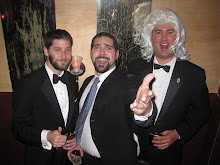We returned to The Columbia Room for the second part of Derek Brown's bitters class. In the last session, we discussed the basic composition and process for building a bitters baseline. The topic of the evolution bitters in the first class was followed up by a discussion in the second class about the turning point for bitters. That turning point was the Pure Food and Drug Act of 1906.
It seems the implementation of this legislation, as well as the Volstead Act fourteen years later, in many ways rendered most of the bitters business unsustainable. Naturally, as time progressed, the ingredient lost prominence among bartenders.
Until recently...
Anyway, as with our last session, cocktails were prepared to exemplify the many applications of bitters. Derek's associate, JP Fetherston, prepared the second session's refreshments. As he prepared, it was noted that Fetherston spends a noble amount of time experimenting and advancing the craft of the bar. The first tipple that he presented us was The 4th Regiment Cocktail.
The 4th Regiment Cocktail
- 1 oz of sweet vermouth
- 1 dash of Peychaud's bitters
- 1 dash of orange bitters
- 1 dash of celery bitters
Glassware: chilled cocktail glass or rocks glass
Combine ingredients in a glass with ice and stir. Pour into a chilled glass. Garnish with a lemon twist. Enjoy.
What makes The 4th Regiment Cocktail a great volunteer for the class is how the drinker is left having to peel back the different layers of flavor. And the most notorious flavor in the bunch seems to have been delivered in some part by the celery flavored bitters. The uniqueness of the celery bitters with the robustness of the sweet vermouth is very clever.
We discussed the flavor profile of the 100 proof vodka used for the maceration process after sampling it. Derek never resists involving his audience in any degustative experience. This inclination is a hint about the world in which Brown lives. Everything must be examined. Take nothing simply at face-value.
As an intermission, Fetherston prepared to demonstrate an aspect of the so-called molecular gastronomy using nothing more than an iSi whip cream dispenser. If you are very familiar with these devices, I ask you: is there any trick this tool cannot perform? Any person who knows the method by which Jose Andres creates his spherification masterpiece, the mojito, will understand why I ask.
And Mr. Fetherston himself is indeed impressive. He treated the class to a demonstration of instant or rapid-fusion; a concept borrowed from Cooking Issues and mentioned here. Within minutes,a few ounces of neutral grain spirit had the rich citrus-orange flavor as though it had been there from the very beginning.
When the time finally came, the host and his assistant prepared the bitter and aromatic ingredients for the students to begin the task of creating their own bitters. Derek encouraged each person to strike his or her own preferred balance by adding more of the former or the latter from their respective pitchers. Regardless of the amounts, the idea seemed to be control - greater control over the process by initially maintaining two seperate bodies of flavor.
Most of us seemed to pour equal amounts from the aromatic pitcher and the bitter pitcher. Then, the various extracts and syrups were passed around for possible inclusion into the mixture. I went with tamarind.
Satisfied with the tamarind flavor, I escalated the water content to dilute the concoction and brighten it up slightly. As a proof of concept, it worked.
Derek concluded his lesson and each student took with him or her a customized jar of bitters. While everyone drifted away, I lingered with the two mixologists on a tangent and was tempted to bait them into extending the hour. Instead, I knew I'd have another chance and saved any wandering inquiry for another appointment.
In the coming weeks, I hope to venture into the cola bitters process. If successful, I'll experiment with a malty cousin to the cola and beer beverages. This soft drink has such a vexing flavor that I have not had the courage to bring it anyone's taste buds as a cocktail. Stay tuned.
Thanks again to Derek Brown, Angie Salame, JP Fetherston, Katie Nelson, and Adriana Salame-Aspiazu for flawlessly executing an educational (and entertaining) set of classes.










No comments:
Post a Comment